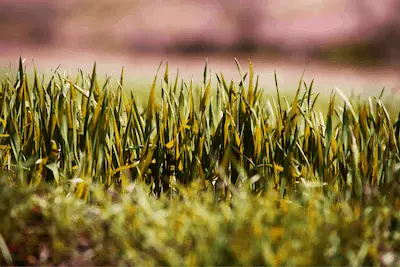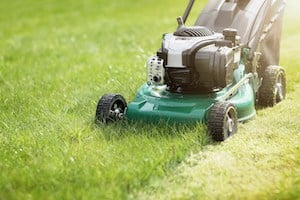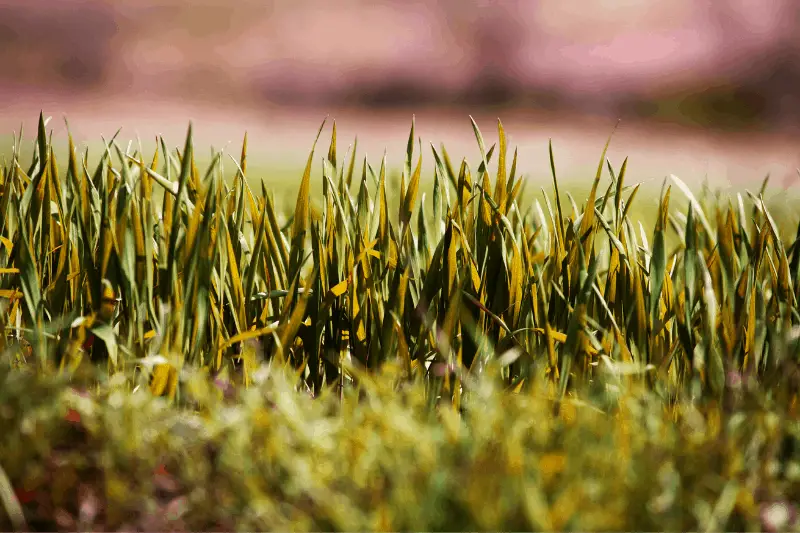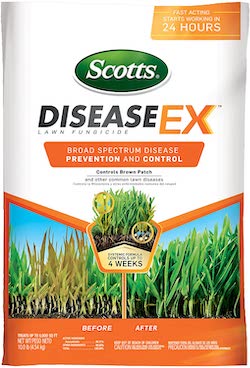Why Your Grass Has Yellow Tips
Who doesn’t love a lovely green lawn? The lush, green grass gives any yard a pleasant appearance. But what happens when yellow tips tarnish it? Can you do anything about these yellow spots that plague your yard, or are you stuck with them once they appear? What are the common causes of yellow tips? Here is the best advice for treating your yellow-tipped grass.
So, why does your grass have yellow tips? If the ends of the grass blades are yellow, but the rest is green, then your lawn mower may be too dull or blunt. If it’s too blunt, it may be tearing the grass and causing it to fray the edges. The tips of your grass then become dried out and turn yellow. You can replace your lawnmower blade to help prevent yellow tips. Yellow tips may also be caused by frost burn.
However, if your grass is entirely yellow, you may have a different cause for the color difference. This could be caused by lack of nutrients like iron or nitrogen, gas spillage, prolonged heat, being cut too short, or being too close to structures or play equipment.
What Causes Grass with Yellow Tips?
 If your lawn has yellow patches, there could be several reasons why. The most common causes of yellow patches are frost burn, dog pee, overwatering, and over-fertilization.
If your lawn has yellow patches, there could be several reasons why. The most common causes of yellow patches are frost burn, dog pee, overwatering, and over-fertilization.
1. Dull Lawn Mower Blades
If your mower’s blades are dull or blunt, they may be snagging and fraying your grass blades, which causes them to turn yellow. You can sharpen your blades or buy new blades if the old ones cannot be repaired. If you plan on having them sharpened, you should go to an expert. Some blades can be sharpened inexpensively.
2. Lack of Proper Nutrients
If your lawn lacks nutrients, you can add a fertilizer that’s rich in vital components. If given a few days, it should gain its color back. When you use fertilizer, always follow the instructions. It’s important to note that too much nitrogen can also turn your grass yellow. This is also the reason your pet’s urine turns the grass yellow. If your dog goes to the bathroom in the same spot repetitively, you may have yellow patches in your yard. You can avoid this by encouraging them to use that you don’t mind them using or other areas of your lawn that do not have grass.
If you currently use a fertilizer, ensure that you apply it to all areas of your lawn. Sometimes it can be easy to miss a spot when applying it. If you miss a spot, you’ll notice discoloration on the leaf blades while the rest of your yard shows signs of deep greening while growing thick and fast.

![]()
3. Spilled Gas
If you have a gas-powered mower, make sure that you refill the gas in a different area. Ensure that you don’t spill gas onto your lawn because it will turn your grass yellow. If you do spill onto your yard, you should clean the spillage up as quickly as possible. Flood the area with water to dilute the fuel and add an absorbent product to collect the fuel.
4. Prolonged Period of Heat of Drought
This can cause your grass to dry out and turn yellow within a couple of days, depending on the grass type. This could also be a sign that your lawn root structure is shallow. By watering your lawn, you are only treating a symptom. Instead, it’d be better to encourage the roots to grow deep. By watering thoroughly and less frequently, you can encourage your grass to root deeply.
Plant roots will stay shallow, looking for more water if you water more often with less water. Giving them a substantial amount of water, they’ll grow downwards and be less likely to dry out during hot conditions. Learn how to help your grass recover from drought here.
 5. Grass Cut Too Short
5. Grass Cut Too Short
If your grass is cut too short, it won’t have enough moisture. When you allow your grass to grow longer and provide it with enough water, you’ll prevent cutting it too short and it turning yellow. You can easily adjust the height of the deck on your lawnmower. If you notice yellow spots or brown grass after you mow, you may be cutting it too short. This can also because the lawn is uneven.
6. Surrounding Structures or Children’s Equipment
Places in your yard that get a lot of use, including areas surrounding swings, playsets, or other children’s equipment, can turn yellow. Often, people who have slip ‘n slides in their yards will experience yellow stripes or spots from where the slide sat. This is likely caused by soil compaction. This happens when the soil is so compacted together. It doesn’t allow oxygen or water to circulate.
To fix this, you’ll have to aerate your lawn. You can use an aerator or use a garden hoe or rake to create holes in the ground at regular intervals to increase oxygen and water circulation. If you have discolored spots due to equipment, don’t fertilize your yellow grass because you want it to use its energy to focus on recovery. Make sure that you stay off the affected area. You should also avoid mowing to keep your grass as stress-free as possible. Also, make sure that you water your lawn correctly.
7. Overwatering Your Grass
Overwatering, as stated earlier, can cause your grass to have poor root system development. Too much water limits the amount of oxygen in the soil which causes the grass’s roots to grow shallow. This can lead to a lack of nutrients, oxygen, and water. This can also cause fungal issues or even insect infestation issues because of reduced resistance.
8. Over-fertilization
Adding fertilizer is a good idea to ensure that your lawn received the proper nutrients. However, you can easily overfertilize your yard, which can burn your lawn. This can be especially true if you use synthetic fertilizer. Excess nitrogen salts in these fertilizers can often burn the leaves on your turf.
This can sometimes be called leaf scorch. If you’ve overfertilized, there can be yellowing at the base of leaf blades, browning at the tip of grass blades, slow growth, and fertilizer crust on the soil surface. If you are using fertilizer to achieve a thick, deep green lawn, use an organic fertilizer that won’t burn your yard. Yellow grass after fertilizing is certainly frustrating but can be easily treated.
9. Lawn Diseases
Sometimes your lawn’s health doesn’t always align with your care. Fungus, dollar spot, and other diseases can cause your property to turn yellow or cause undergrowth. Frost burn and large amounts of rain can also cause yellow leaf blades. These may not kill your grass, though. Through treatment, you can stop your grass from discoloring further. Learn how to troubleshoot lawn damage and diseases here.
 How to Turn Your Yellow Grass Green
How to Turn Your Yellow Grass Green
As soon as you notice discoloration, you should start to take steps to help your lawn maintain its health. Fortunately, there are many ways to turn a yellow lawn green. If you’re worried about urine spots, you may want to follow your pet and apply a neutralizer as soon as they urinate. You can also reseed or resod your lawn if you already have urine spots.
By adjusting your water routine and watering it when needed, you can help your grass stay green longer. If there’s a lot of rain, you can change how frequently you water so that your yard doesn’t become waterlogged. Remember to water your lawn when the top two inches of the topsoil is dry.
Ensure you water your property following the proper maintenance of your specific grass in your yard. Typically, most lawns do best when you water them two or three times per week. You can also try to reduce the amount of water when irrigating your property to the recommended level according to your grass type. To ensure that you are taking proper care of your lawn, talk to your local lawn care expert for advice.
If your lawn is turning yellow due to overfertilizing, you could try a slow-release, organic fertilizer. You can do a soil test to determine what nutrients your soil lacks, so you know what fertilizer is right for your lawn. Ensure that you apply any fertilizer according to the specifications on its label. You’ll also want to feed your lawn the proper amount.
If your lawn is yellowing due to lawn disease, do your best to diagnose and treat it. Any lawn disease can slow your grass’s growth and create symptoms like spotting or wilting. Treat any fungal infections or other conditions as soon as you see signs. Most lawn diseases are fungal in nature originating from dampness. You may also want to treat your lawn after winter to kill any fungus that could have developed.
Lastly, mowing with sharper blades can help keep your yard green. If your lawn mower’s blades have dulled, you can sharpen your mower blades. You may even want to consider a reel mower that cuts cleaner compared to a gas-powered mower. All of these tips can help you maintain the healthy and lush, green look of your lawn.
![]() Are you looking for a better way to protect your lawn and home? Your lawn care problems and perils may have coverage under your homeowner’s insurance policy!
Are you looking for a better way to protect your lawn and home? Your lawn care problems and perils may have coverage under your homeowner’s insurance policy!
Thank you for reading American Lawns! Find more lawn tips and outdoor living tricks here.




